

Python Course: Modular Programming and Modules. Modular Programming If you want to develop programs which are readable, reliable and maintainable without too much effort, you have use some kind of modular software design.
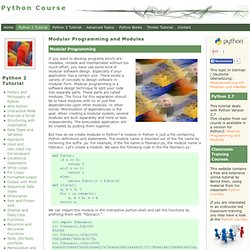
Especially if your application has a certain size. There exists a variety of concepts to design software in modular form. Modular programming is a software design technique to split your code into separate parts. These parts are called modules. But how do we create modules in Python? Def fib(n): if n == 0: return 0 elif n == 1: return 1 else: return fib(n-1) + fib(n-2) def ifib(n): a, b = 0, 1 for i in range(n): a, b = b, a + b return a We can import this module in the interactive python shell and call the functions by prefixing them with "fibonacci A local name can be assigned to a module function to get shorter names: >>> fib = fibonacci.ifib >>> fib(10) 55 >>> More on Modules Usually, modules contain functions, but there can be statements in them as well.
Importing Names from a Module Directly. Planet Python. The Python Tutorial — Python v2.7.1 documentation. Python is an easy to learn, powerful programming language. It has efficient high-level data structures and a simple but effective approach to object-oriented programming. Python’s elegant syntax and dynamic typing, together with its interpreted nature, make it an ideal language for scripting and rapid application development in many areas on most platforms. The Python interpreter and the extensive standard library are freely available in source or binary form for all major platforms from the Python web site, and may be freely distributed.
The same site also contains distributions of and pointers to many free third party Python modules, programs and tools, and additional documentation. The Python interpreter is easily extended with new functions and data types implemented in C or C++ (or other languages callable from C). This tutorial introduces the reader informally to the basic concepts and features of the Python language and system.
The Python Standard Library — Python v2.7.1 documentation. While The Python Language Reference describes the exact syntax and semantics of the Python language, this library reference manual describes the standard library that is distributed with Python.
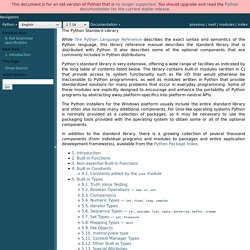
It also describes some of the optional components that are commonly included in Python distributions. Python’s standard library is very extensive, offering a wide range of facilities as indicated by the long table of contents listed below. The library contains built-in modules (written in C) that provide access to system functionality such as file I/O that would otherwise be inaccessible to Python programmers, as well as modules written in Python that provide standardized solutions for many problems that occur in everyday programming. Some of these modules are explicitly designed to encourage and enhance the portability of Python programs by abstracting away platform-specifics into platform-neutral APIs.
Dive Into Python. Python Tutorials, more than 300, updated March 2, 2009 and carefully sorted by topic and category. The Web framework for perfectionists with deadlines. Style Guide for Python Code. Code should be written in a way that does not disadvantage other implementations of Python (PyPy, Jython, IronPython, Cython, Psyco, and such).For example, do not rely on CPython's efficient implementation of in-place string concatenation for statements in the form a += b or a = a + b.
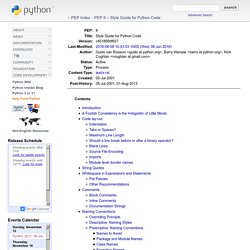
This optimization is fragile even in CPython (it only works for some types) and isn't present at all in implementations that don't use refcounting. In performance sensitive parts of the library, the ''.join() form should be used instead. This will ensure that concatenation occurs in linear time across various implementations.Comparisons to singletons like None should always be done with is or is not, never the equality operators.Also, beware of writing if x when you really mean if x is not None -- e.g. when testing whether a variable or argument that defaults to None was set to some other value.
The other value might have a type (such as a container) that could be false in a boolean context! Matplotlib: python plotting — Matplotlib v1.0.1 documentation. WxPython. Package Index : PyPI. BeginnersGuide. New to programming?
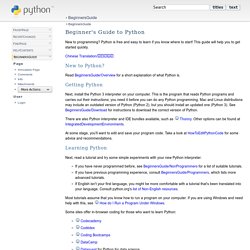
Python is free and easy to learn if you know where to start! This guide will help you to get started quickly. Chinese Translation. Documentation Index. Notice: While Javascript is not essential for this website, your interaction with the content will be limited.
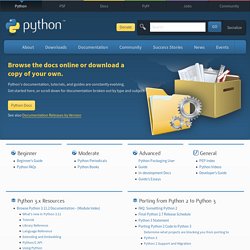
Please turn Javascript on for the full experience. Beginner Moderate Advanced General. Python. Python Programming Language – Official Website. Blender 3D: Blending Into Python. This is the start of a Blender/Python manual.
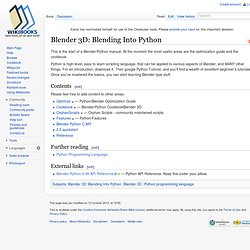
At the moment the most useful areas are the optimization guide and the cookbook. Python is high-level, easy to learn scripting language, that can be applied to various aspects of Blender, and MANY other things. For an introduction, download it. Then google Python Tutorial, and you'll find a wealth of excellent beginner's tutorials. Once you've mastered the basics, you can start learning Blender type stuff. Contents[edit] Please feel free to add content to other areas. What is wxPython? The Python Challenge. SciPy - Learn Python in 10 minutes.
NOTE: If you would like some Python development done, my company, Stochastic Technologies, is available for consulting.
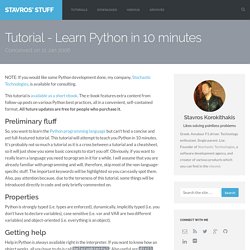
This tutorial is available as a short ebook. The e-book features extra content from follow-up posts on various Python best practices, all in a convenient, self-contained format. All future updates are free for people who purchase it. Preliminary fluff So, you want to learn the Python programming language but can't find a concise and yet full-featured tutorial.
Properties. Popular Python recipes. Overview — Python v2.7.1 documentation. Dive Into Python.